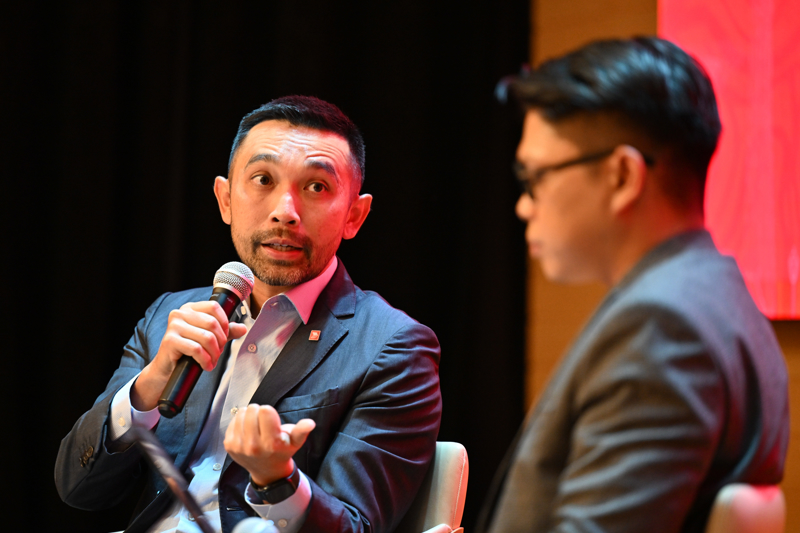As one of an ASEAN-focused bank with the operation in 7 markets in the region, CIMB wants to find its niche in each of the markets it operates in, instead of trying to serve every customer segment across ASEAN, Mr. Novan Amirudin, Group CEO, CIMB, told attendees at the bank’s media day on July 21 in Kuala Lumpur, Malaysia.
“We’re looking at sharpening our focus in (each market) to improve our returns as a niche player, rather than trying to be a more universal player,” Mr. Amirudin said.
As for Vietnam and the Philippines, CIMB operates as digital banks in these two markets with full banking licence. The bank chose to partner with e-commerce players in the Philippines to scale faster, while in Vietnam, CIMB Vietnam provides banking products and services for individuals and partners with a digital orientation, bringing convenience, safety and security to customers.
Specifically, Mr. Amirudin reveals that the bank has allocated about 1 or 2 per cent of capital towards developing digital banks in Vietnam and the Philippines and achieved significant benefits. “In Vietnam and the Philippines, we learn exactly how to operate and to expand digitally, whether is it digital internal processes, digital ways of reaching out to customers, and we are then implementing it as we digitize the entire CIMB group,” he added.
In fact, according to the State Bank of Vietnam (SBV), the total value of non-cash payments in 2024 reached over VND295.2 quadrillion (approximate $11.3 trillion), 26 times higher than Vietnam's GDP. At the same time, Vietnam's population aged 15 and over with bank accounts reached 86.97 per cent. By the end of the first quarter of 2025, non-cash payment transactions increased by 44.43 per cent in quantity. Of which, payments via the Internet increased by 40.41 per cent, via mobile phones by 39.82 per cent, and via QR code by 81.64 per cent.
Meanwhile, Singapore serves as a wealth and treasury hub for the bank to connect to the wider ASEAN region. In Indonesia, Mr. Amirudin is positive on the growth of its Islamic banking business, given that penetration for the segment is low despite the country having a large Muslim population. Thailand and Cambodia serve as strong centres for its cross-border wholesale segments.
“By focusing on its strengths in the individual markets, this can help the bank better allocate its resources to grow, especially in times of uncertainty,” he said. “We will operate in all these different jurisdictions based on how we can contribute to customers and societies in that particular market. If we cannot play a meaningful role, then we need to find a different angle for us to play a meaningful role.”
Mr. Amirudin also said that US tariffs are also a significant issue but he is still confident it can weather the effects of rising tariffs and economic uncertainties through a mix of income diversification, operational efficiency, and risk management. “Rising tariff could hurt economic growth which in turn may affect loan growth but the bank is not solely dependent on loans for income,” he added.
According to the Forward30 strategic plan, CIMB aims to grow its non-interest income segment to help cushion the impact of economic uncertainties. About 30 per cent of its income comes from non-interest sources such as fees, foreign exchange and consulting, which are an important part of Forward30 to offset the decline in net interest margins in a low-interest rate environment. The development orientation in different markets in ASEAN, including Vietnam, is included in this strategic plan.
Looking foward, Mr. Amirudin said that the US tariffs could negatively impact the economy and affect credit growth. The shift of supply chains from China to ASEAN could increase supply in some sectors such as automobiles, affecting local companies, requiring close monitoring. In addition, global geopolitical risks have also caused oil price volatility, raising concerns about inflation and dampening consumer spending.
On the other hand, according to CIMB’s data, in the first half of the year, ASEAN equities markets performed 6.8 per cent, lower than expected, despite global equities rising 10.3 per cent, with the MSCI Asia Pacific Index up 12.6 per cent and China up 23 per cent. Malaysia fell 5.7 per cent, while Singapore performed well.
CIMB recommends investors focus on fixed income, which is predictable, sustainable and stable as a way to reduce risk during uncertain times. To address the risks, CIMB has restructured its portfolio over the past few years, exiting high-risk sectors, reducing credit losses and increasing coverage. Less than 3 per cent of its loan portfolio is trade-related and less than 0.4 per cent of its clients derive more than 20 per cent of their revenue from the US, helping to mitigate tariff risks.
The bank also uses AI to automate processes, monitor transactions, detect fraud and improve customer service, thereby reducing costs and increasing efficiency.
At the same time, CIMB has demonstrated its commitment to the environment, funding RM300 billion (over $70 billion) in ESG projects, not only to keep up with trends but also to “future-proof” its business and clients, meet sustainability standards and ensure its presence in the global supply chain.
By 2030, CIMB aims to achieve a top three in net promoter score, top quartile ROE among regional peers, current and savings account ratio of 45 per cent, non-interest income ratio of between 33 and 34 per cent, and cost-to-income ratio in the low 40 per cent.









 Google translate
Google translate